by Winding Pathways | Jun 8, 2023 | Garden/Yard, Nature, Pests
A “Hard Knock Life”
A tick’s life is hard. I’m hungry. I am a tick and I’ve been waiting a week for a juicy raccoon, dog, or wild turkey to walk by. Even a mouse would be welcome.
So far, no luck. I know a tick’s best bet for grabbing a passing animal is the “questing” position, so I’ve been hanging on to a branch with both pairs of my hind legs. My front pair of legs sticks out into the path ready to grab the fur or feathers of a passing animal. So far, no animal. Patience is hard and I’m hungry.
Larval Luck
I was luckier last year when I was a larva. I was hungry then, too, but the wait was short. A big, furry animal humans call a dog ambled by. Even though I only had six legs then I was able to grab a hold, and the rest was easy. I crawled around exploring under the fur until I found a spot with soft thin skin, dug in, and chowed down. Boy was that blood tasty! It was so nutritious that I left my host to grow and graduate. I’m now a tick nymph, complete with eight legs, but I need more blood to transform into an adult.
I’m still hungry. As I sit waiting, I admire the mosquitoes and flies that buzz by over my perch. They don’t need to be patient but can fly and search for a blood-rich victim. I can’t fly or jump, so all I can do is patiently wait until something walks by. I hope that’s soon because many of my fellow ticks starve.
Attracted to Carbon Dioxide and Moisture
What’s this? I sense a bubble of carbon dioxide and moisture. Might be the breath of an animal. Now I feel the vibration of footsteps. Must be a big animal. My front legs are outstretched in anticipation and I’m not disappointed.
I grab hold of a strange animal. It’s tall with only two legs. No hair. No feathers. Just some sort of covering over thin skin. No chance of biting through it, but I got a good grip on that covering and started climbing using all of my eight legs. Soon I was under what humans call pants and kept exploring and climbing. Bingo, I found a nice moist spot where my blood dinner was just beneath thin skin. I got ready to feast.
Then something happened. I should be happy with a meal so close at hand. Instead, I felt sick. My legs wouldn’t hold on and I dropped to the ground lifeless.
About Ticks
Pity the poor tick the above. Well, maybe not. It’s hard to pity an animal that can spread disease and discomfort. Ticks usually feed on mammals, birds, and even reptiles but if none come around, human blood suits them just fine.
Ticks are effective disease spreaders because of their relatively long life which can extend for two or three years and their habit of eating a blood meal during different life stages. This enables them to bite one animal carrying a disease in its blood and inject it into a different animal during a later feeding.
Seriously Avoiding Ticks
At Winding Pathways, we take ticks seriously. Rich has had Lyme disease twice, fortunately successfully cured by strong antibiotics. Other people are not as lucky and experience long-term symptoms. And, Lyme is not the only disease ticks spread.
Understanding ticks and taking precautions reduces the odds a person will be bitten and contract a disease from them.
How ticks Operate
Ticks are ambush hunters. As the tick describes above, they wait for a victim to pass within grabbing distance of their front legs. Often ticks walk around on their victim for several hours before they dig through the skin and help themselves to a blood meal.
In order to contract a tick-borne disease a victim must be bitten, so a walking tick won’t transmit illness.
Reduce Your Odds
We often explore the woods, work in our yard and garden, and generally spend time in tick country. Here are precautions we take that reduce the odds of a tick bite:
- We spray our outdoor clothes and shoes with permethrin. It lasts for several washings and kills ticks. The hapless tick described above fell victim to this chemical.
- We often tuck our pants legs into our socks, sprayed with permethrin, to make it hard for any tick that gets on our socks or pants to get under them.
- After returning to the house, we disrobe and shower after we have checked for ticks. They prefer moist dark body areas so we especially check those places. Clothing goes into the washer.
- We watch for symptoms of Lyme Disease, especially a rash and fatigue. If they appear we call our physician immediately.
Promising Product
A few years ago, Rich was so determined to prevent another Lyme Disease incident that he invested in socks, pants, and shirts from Insect Shield. The company infuses its clothing with permethrin that, they claim, is effective for at least 70 washings.
Does this chemical work? Is Insect Shield clothing worth buying? Well, since wearing it Rich hasn’t found a tick on him and he’s been free of Lyme Disease. That’s not a scientific verdict but it’s good enough for him to keep wearing the clothes.
-
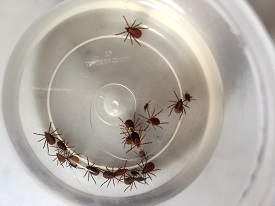
-
Tiny ticks can cause problems, so we go prepared in nature.
-
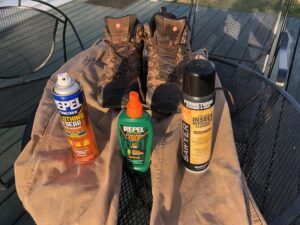
-
Pants, boots, varied sprays can reduce odds of picking up ticks
-
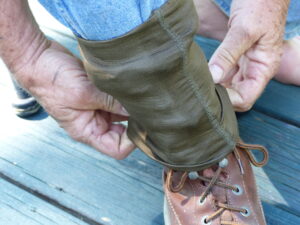
-
gaiters with tick guard helps repel ticks.
-
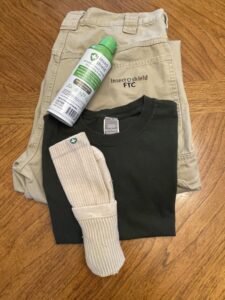
-
Pants, shirts, and socks infused with permethrin appear to keep ticks off.
Disclaimer
Rich purchased his Insect Shield clothing at the retail price. He’s still testing them but they seem to work. Winding Pathways was not paid for this blog.
by Winding Pathways | Feb 2, 2023 | Foraging, Nature, Pests, Trees, Trees/Shrubs
Disappearing Ash Trees
Ash trees are fast disappearing from American forests and towns. It’s tragic.
There are several ash species, including white, green, blue, and black. A Chinese native insect, the Emerald Ash Borer, is killing them all quickly. It’s awful.
Years ago, Dutch Elm Disease cleared cities of American elms, and many homeowners and towns planted green and white ash trees to replace them. Ashes, in general, thrive in the woods and towns. They grow relatively quickly, resist storm damage, and are beautiful. They seemed like an ideal urban tree.
That was true until Emerald Ash Borers were found in Michigan in 2002, although they may have been around at least a decade earlier. Since then, the insect has spread like crazy, killing ashes radiating outward from Michigan.
They reached Iowa years later and have since killed most of the trees in Cedar Rapids, area woodlands, and many other towns.
Salvaging Ash trees
Rich salvages wood from a scrap pile of used pallets. Pallets are made from cheap wood, like cottonwood, poplar, and hackberry, but now he’s finding ones made of ash.
Loggers are salvaging dead and dying ash trees, and the wood is cheap, at least for now. Soon ash lumber will no longer exist.
A Versatile Wood
Sports fans will miss ash wood. It makes the best baseball bats and has been used for gymnastic bars.
Ash also is crafted into gorgeous furniture.
We lost our big ash tree in the August 2020 derecho, but it was already infested with borers with its days numbered. Sadly, we cut the tree up but gave it a second task. It harvested solar energy and used it to make wood. That wood is now being fed, piece by piece, into our woodstove. It’s keeping our home warm, but we’d rather have our tree.
-

-
Ash bat on oak floor.
-

-
The ash tree anchored our east corner of the property.
-

-
White Ash bats will soon be a memory as these elegant trees die.
by Winding Pathways | Sep 15, 2022 | (Sub)Urban Homesteading, Birds, Garden/Yard, Mammals, Nature, Pests
Guest Blog by Jackie Hull,
in the foothills of Virginia
Bears Barely Tolerable Behavior
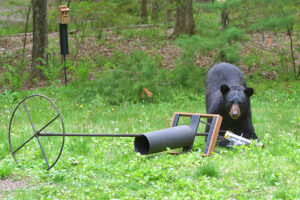
Bear Raiding Feeders
Well, the bear did it again. It tore up some of the spindles on the porch railing, tipped over a couple of the vegetable pots, and yanked a six-foot portion of our picket fence off the posts. All this to remind me that I should not feed the birds this time of year. It’s May.
So what to do but put away all the feeders? Maybe I can try again in the fall when bears retreat to the dens for their winter snooze.
This pretty much gave me great moments of sadness especially since I’ve had to shed other favorite activities.
Bird Antics Bring Joy
But today was a day of great surprises. My beautiful main stays, the birds, were everywhere. As I sat in the kitchen peering out the window, I spotted the adult turkeys poking their heads above the uncut hay. I could feel their parental thoughts “The coast is clear so keep scrambling forward.” The chicks were not seen but definitely there. A goldfinch zipped over them. Then I saw two wood thrashers near the holly tree scavenging for insects. Oh, my look how that crow struts!
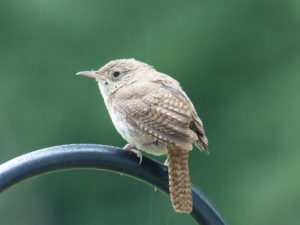
Wrens are Chatterers
Listen, that’s the wren by the back door. She keeps chattering to remind me she built her condo in the hanging planter. Then a flash of bright red caught my eye as I walked onto the porch. It’s a cardinal. Then the female house finch flicked from her nest over the front door light. She doesn’t like me stepping onto the porch. She is quite timid.
Even though the feeders have been down for nearly two months, the birds have kept their vigil at my country home much to my delight. They are in the trees, along the lane, and in the hayfield. What a great day!
by Winding Pathways | Feb 10, 2022 | Birds, Mammals, Nature, Pests
Guest Blogger, Dr. No More Squirrels
(Photos by Dr. NMS)
Much of my time and energy has been spent battling a 1-pound enemy – the gray squirrel. I love feeding and watching birds, but with a neighborhood full of acorn-bearing oak trees I feel no guilt at all at not wanting to pay for bird food and letting the squirrels eat it. Through trial and error, I have found how to place all our feeders so that they are always out of the reach of squirrels. Almost always. Every few months a new guy shows up; a determined daredevil squirrel who figures out how to slide 20 feet down the string holding a feeder to get to the mother lode.
-
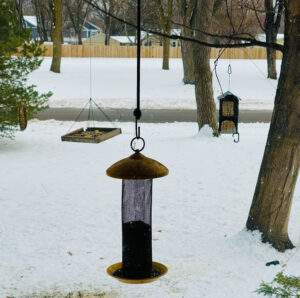
-
A variety of feeders for the birds.
-
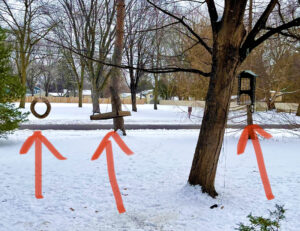
-
the “raiders” jump through hoops to get to the feeders.
When that happens, it’s time for an involuntary relocation.
This was the case on a frigid January morning here in Minneapolis. My live trap was set and within minutes I heard it snap shut. But what I then saw was a shock. The squirrel was trapped all right, but sitting next to the trap was an immature red-tailed hawk! She hopped onto the trap and all around it, trying to get at what she thought would be an easy breakfast.
Minutes later, she gave up and flew to a nearby perch to contemplate how she had been beaten by a 1-pound ball of gray fur.
I knew exactly how she felt.
-
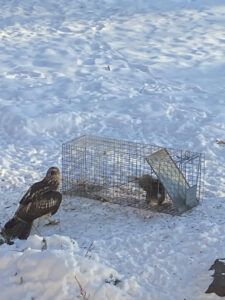
-
This immature red-tail hawk tries to figure out how to get the squirrel.
-
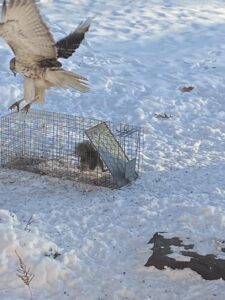
-
Landing on the trap
by Winding Pathways | Jan 6, 2022 | Birds, Nature, Pests
Artful Dodgers
Walking one of Cedar Rapids’ trails sometimes is like a skier racing a slalom course. Instead of weaving between flags, pedestrians must dodge piles of goose poop.
It wasn’t always that way. Before the mid-1980s few geese lived in town. Cedar Rapids began restoring them. About 125 of the giant birds were released near downtown. Few predators pester them and are they prolific! A goose couple can live for decades and raise upwards of a dozen goslings a year. That is a lot of geese!
Geese Mixed Blessing
Canada geese are a blessing. We love hearing “goose music” as they wing over our house. Watching such attentive parents teach their babies to swim and find food is great fun.
Canada geese are a curse, mostly because there are so many of them and they enjoy living, and pooping, in town. Their droppings are more than a walking nuisance. Loaded with nitrates and bacteria, they stimulate algae growth, lowering water quality.
-
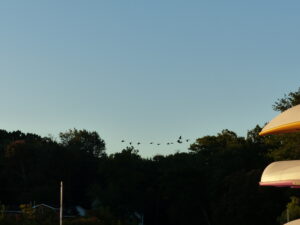
-
We enjoy the haunting call of geese on the wing.
-
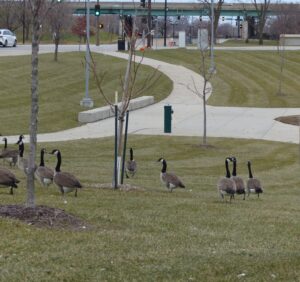
-
Geese love short grass
Geese Requirements
Geese love water but don’t need massive remote lakes. They prefer the dozens of small ponds at golf courses, corporate and school campuses, and parks. A lawnmower is a goose’s best friend. Well, maybe not a mower, but close-cropped lawns have tiny tender grass shoots that make fine goose dining. Running a mower down to a pond’s edge creates goose paradise. And problems for landowners.
People sometimes put snarling coyote mannequins near their pond to scare the big birds. It might work for a minute or two, but geese are smart. They figure out it’s a fake and nibble tender grass right under the phony predator.
How to Discourage Geese
Some cities reduce goose numbers by locating their nests, shaking the eggs to kill the embryos, which is called addling, or coating the eggs with oil so they won’t hatch. It may work to reduce flock size, but geese are protected by federal and state laws. Destroying eggs without a permit is illegal.
Legal Tricks
Here are less lethal and legal tricks that work, at least to some degree to discourage geese:
- Hold the chow. Folks love tossing stale bread to waterfowl, but it just encourages the crowding of the pesky birds.
- Stow the mower and let the grass grow. Geese shun tall grass. Even better, plant tall prairie grasses near the water’s edge.
- Fence ‘em out. For some reason geese don’t usually cross even small low barriers they could hop or fly over. A fence of lightweight plastic pipe set parallel to the edge of the water may discourage them from entering small areas.
We’ve got them. Geese are fellow city residents. We need to coexist, but a few simple tricks can discourage them from certain areas while still letting us enjoy delightful goose music as they wing overhead.
by Winding Pathways | Oct 7, 2021 | (Sub)Urban Homesteading, Chickens, Garden/Yard, Nature, Pests
There’s a Mouse in the House!
Sooner or later anyone who keeps a few chickens is likely to spot a mouse scurrying across the coop floor. Most sightings are after dark when hens are snoozing on their roosts. That’s when nocturnal mice seek a chicken feed dinner.
Commercial chicken feed is nutritious to more than chickens. Small rodents also thrive on it. They eat expensive feed and also foul it with their urine and droppings. Mice should be eliminated from the coop.
Two general types of mice can be found in places where both people and chickens live. European house mice are common all over the world. They usually spend their entire lives in a home or chicken house and rarely venture outdoors. These tiny rodents are dark gray all over. White-footed, or deer, mice are native rodents that commonly visit coops and the homes of the flock owner. They are easy to distinguish from house mice since, as their name implies, they have white feet and bellies.
While house mice live in a coop year round white-footed mice are more likely in cooler months. House mice usually eat food in place, while white footeds often carry seeds a distance and cache them in a hidden place to nibble on later. Find a pile of corn in an old boot or any other hidden place and the culprit is likely a white-footed mouse.
It’s not good to have either type of mouse mixing with chickens. Although it’s probably not possible to totally eliminate them, several actions greatly reduce their abundance.
The best strategy for reducing mouse infestations in either a house or chicken coop is to keep them out. Mice are tiny and athletic. They can squeeze through small holes and cracks, the same openings that let cold drafts enter. Keep both mice and cold air outside by filling in holes and cracks with caulking. The best time to do this is in early fall before cold weather settles in. Filling cracks also keeps box elder bugs, Asian beetles, and other insect pests outdoors. Cracks can be anywhere but are especially likely around window and door frames and where wires and pipes enter a structure.
Contain Food
Mice enter a chicken coop to find shelter from bad weather, safety from predators, and dinner. They love eating grain and chicken mash or pellets. Anything edible in the coop should be stored in metal containers with tight-fitting lids. Mice easily chew through plastic ones so avoid them. Use metal trash cans instead. Mice will help themselves to feed in a feeder, and most people leave feeders exposed at night. Since chickens don’t eat during dark hours put feeders in a tightly lidded metal garbage can overnight. This will keep mice away from them. The feeders can simply be put back where the chickens can access them the following morning.
Encourage Owls
A neighborhood owl family can be a chicken’s best friend. Owls love dining on mice. Great horned, barred, and screech owls are relatively common in suburban areas and patrol nighttime neighborhoods seeking small mammals to catch and eat. Owls are active when chickens are securely sleeping in the coop. This reduces the odds that a hen will end up an owl meal. According to Karla Bloem, Executive Director of the International Owl Center, owls can be a chicken keeper’s best friend.
Avoid Poison and Glue Boards
Although it’s tempting to use poison to rid a home or chicken coop of mice it should be avoided for these reasons:
- Poisoned mice might be eaten by chickens, non-targeted wildlife, and pets. They can be sickened or killed by residual poison in the mouse’s body.
- Poisoned mice sometimes die between walls or in inaccessible places. Soon their bodies smell terrible.
- Poison is slow acting and cruel. A quick death by a snapping trap is more humane.
- Chickens, children, pets, and nontarget wildlife might find and eat the poison.
Glue boards are pieces of cardboard or heavy paper covered with an extremely sticky substance. A mouse walking over a glue board will be held tightly. They can’t escape. While glue boards catch mice they also catch non-targeted animals. Any human who touches the sticky stuff will struggle to get free of it. Mice caught in glue boards usually starve to death or are found alive and struggling. It’s cruel.
Mice are relatively easy to trap using any of the many devices on the market. Most common are snap-type traps that have been effectively catching small rodents for over a century. For people who prefer not to touch a dead mouse, newer type traps enclose the entire body. Some traps are even electronic and electrocute the poor animal. There’s even a trap that will alert a cell phone when a mouse has been caught.

Place several traps side-by-side along a wall where you have seen evidence of mice.
Despite the fancy new type traps the old-fashioned kind, baited with peanut butter or soft cheese, is most common and least expensive. Traps should be set in places where chickens, pets, and children can’t access them. It’s best to set traps in the evening and either spring or retrieve them the next morning. Following are tips for increasing trapping success:
- Mice tend to run parallel to walls. Set traps next to walls with the trigger end closest to the wall. Traps with yellow plastic triggers that look like cheese may be slightly more effective than the older traps with metal triggers.
- Set traps in pairs or triplets. Put two or more traps side by side along the wall for the best odds of catching a fast-running mouse.
- Set out many traps. The best way to reduce mouse numbers is to catch all, or most, of the mice in the same evening.
- Don’t assume they’ve all been caught. Usually, there are many mice in a coop or home. Once most have been caught, keep setting them. Likely a few mice remain or new ones may enter.
Dispose of dead mice by flushing them down the toilet, putting them in the trash, burying them, or placing them in a woodsy or tall grassy area for scavengers to eat. Chickens will eat mice, also. Wash your hands well after touching the traps or mice.
Reducing mouse numbers in a coop is an important part of chicken husbandry. It takes some effort but preventing an infestation and trapping any that lurk in the coop is important.
*Reprinted with permission from Hoover’s Hatchery.
















